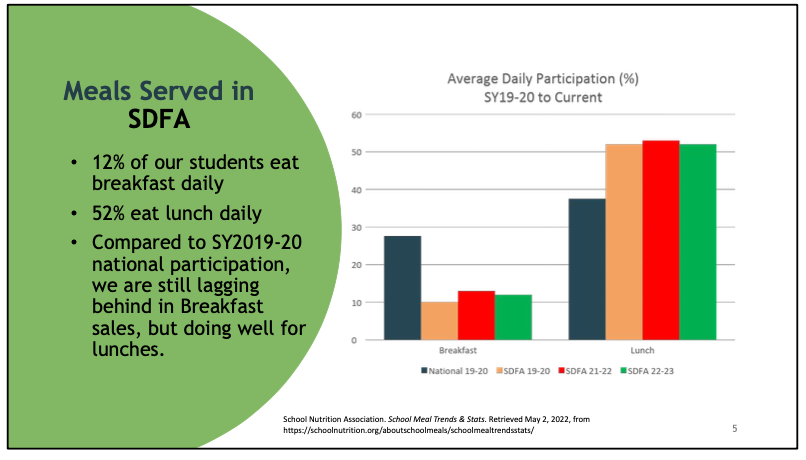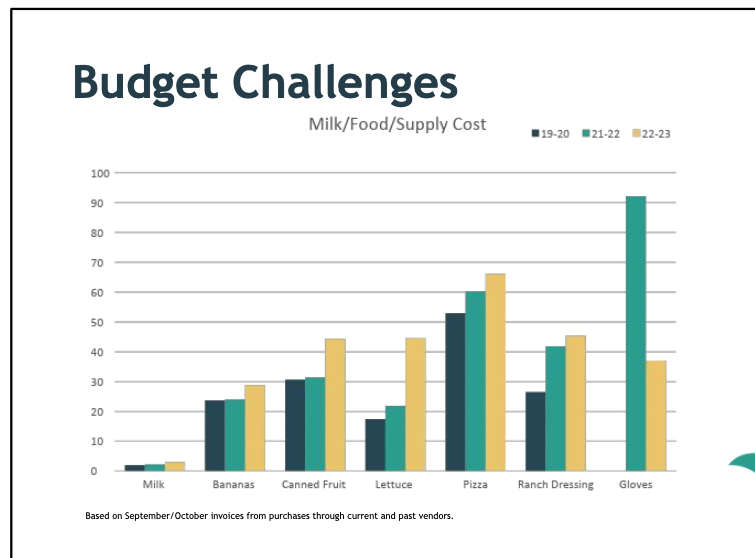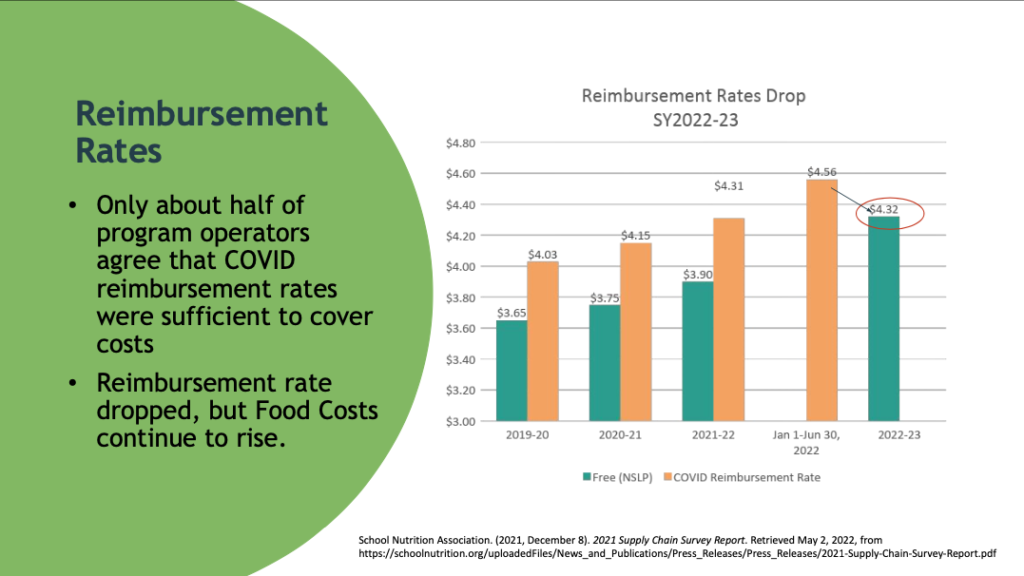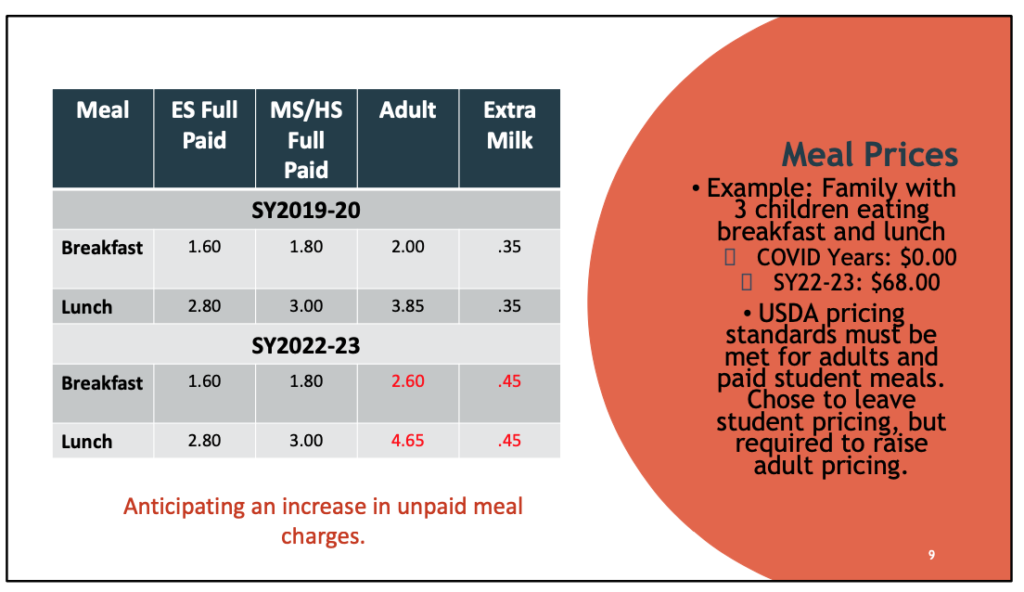By Kim McDarison
The School District of Fort Atkinson Board of Education last Thursday received the annual Nutrition Services Report as presented by Director of Nutrition Services Christina Oswald. The report offered an overview of the department and the various processes it uses to feed the district’s students.
Aided by slides, Oswald said the report would cover the department’s finances, some highlights from within “the last few months,” and ideas for the department’s future.
Within her report, Oswald cited the district’s Fund 50, used to finance nutrition services, and end-of-year balances across several school years. She reported that in the 2018-2019 school year, the balance was $16,064, while in 2019-2020, it was $229,532, and in 2020-2021 and 2021-2022 it was $352,030 and $652,098 respectively.
Oswald said the pandemic “really didn’t have a negative effect on our department at all, which was wonderful. As a matter of fact, it really has afforded us the opportunity to make a lot of improvements within our kitchens.”
Recently the department invested in equipment at the high school which allows the department to increase its commitment to scratch cooking, she said. With the new equipment, the department acquired the capacity to scratch cook for more than 1,000 students at a time.
Additionally, she said, the department was in the process of replacing ovens at both Barrie and Rockwell elementary schools with equipment she described as a state-of-the-art combination oven-steamer. The new equipment will “improve the quality of the food at those two schools,” she said.
Oswald said the increased Fund 50 balance was achieved through “cost saving measures” and “the fact that the government was more than generous with what they were giving us for meals during the pandemic.”
Board of Education member Chris Rogers expressed surprise at the more than $600,000 balance, asking: “Am I seeing that right?”
Oswald said the number was correct.
Rogers asked if the money would be used to pay future expenses.
Oswald said it would, noting that the department incurs costs of approximately $150,000 each month. She said the state likes to see a Fund 50 balance maintained that could cover three months worth of department expenses.
“We are actually well over that, and that’s why we are trying to find some projects and improvements that we can make, because when we go through our annual review, which, right now is slated for the ’23-’24 school year, they (state regulators) will ask us to start spending some of that and reinvesting that into our kitchens and into our program,” she said.
Rogers asked if the money was achieved “solely by what the students pay” or if additional funding was coming through the district’s budget.
Said Oswald: “That particular came during COVID where the students were not paying anything for meals. That was strictly federal dollars that we received based on the amount of participation.”
School District of Fort Atkinson Superintendent Rob Abbott, responding to Rogers, said: “One of the things that we are particularly proud of Mr. Rogers is during COVID the nutrition services department literally served hundreds of thousands of meals and we took full advantage of all the opportunities from the federal government related to those special circumstances, so the number of meals served — the way that Mrs. Oswald has been working the nutrition services department and just utilization of the program, has been building the ability to use some of those funds toward future improvements.”
Oswald said that monies received through the government in the form of COVID relief ended in June.
“Now we are kind of back to what would have been considered normal reimbursement rates,” she said. She defined those reimbursement rates as $4.32 per free meal.
Abbott noted that the nutrition department is “self-functioning,” adding: “It’s a self-contained budgetary unit. So there are not regular budget dollars used to supplement the nutrition services department. These funds need to remain in that department and that department needs to maintain itself.”

The slide above and its bar graph compares three school years worth of School District of Fort Atkinson breakfast sales data (represented within the first set of bars) and lunch sales data, with the 2019-2020 national average (represented within both sets of bars by the bar shown in dark blue). As depicted by the graph, the district has achieved fewer dollars in breakfast sales as compared to the 2019-2020 national average and produced more lunch sales than the 2019-2020 national average during the 2019-2020, 2021-2022 and the 2022-2023 school years.
Number of meals served
Oswald next offered a slide showing some statistics about meals served within the district.
The slide noted that 12% of the district’s students eat breakfast daily, and 52% eat lunch daily.
Compared with the 2019-2020 school year, the slide stated that the district is still “lagging behind in breakfast sales, but doing well for lunches.” A bar graph compared several years worth of school district statistics with the 2019-2020 national average.
As depicted by the graph, the district has produced more lunch sales than the 2019-2020 national average during the 2019-2020, 2021-2022 and the 2022-2023 school years.
“The reason we go back to the ’19-’20 school year is because that was pre-COVID, so that gives, on a national level, kind of the best picture of what a normal functioning school year would look like, she said, adding that statistics developed within the graph for the district were based on “September/October numbers.”
Citing breakfast statistics, she said: “As you can see, we are well below the national average for breakfast, so that’s something that I’m definitely going to be looking how we can improve our breakfast numbers, but a lot plays into that, based on busing and when kids are brought to the buildings to even participate in breakfast. We have a lot of schools nationwide that are participating in breakfast in the classroom, which is not something that the School District of Fort Atkinson is currently participating in. So there’s a lot of opportunity for growth within breakfast.”
Citing lunch statistics, she said: “If you look at the national average compared to where we are, we are significantly higher than the national average — have been now for a number of consecutive years — and what I’m very proud of is when you compare the red line, the ’21-’22 school year with the current green line, even though we were giving away those meals for free, and now we’ve gone back to paid, we have not seen a significant drop in participation at all. As a matter of fact we have some schools that are actually serving more meals this year than I have seen served at those schools since starting here in October of 2019.”
School board president Kory Knickrehm asked: “What do you attribute that to?”
Oswald responded: “Quality food. Fresh food. We really have made a lot of changes since I started in 2019.”
She noted a move by the department away from processed foods, opting, instead, to do more cooking from scratch.

The graph above shows the rising cost of food items such as milk, bananas, canned fruit, lettuce, pizza and ranch dressing, as well as the decreasing cost of gloves used by nutrition department staff members, over the course of three school years: 2019-2020, 2021-2022, and 2022-2023.
Increasing costs
Oswald next talked about rising food costs and their effect on her department’s budget.
The cost of food items such as milk, bananas, canned fruit, lettuce, pizza, and ranch dressing had all increased, she said. She noted a drop in the cost of gloves used by workers, which, she said, had, since the pandemic’s inception, markedly gone down in price.
Pointing again to the department’s Fund 50 balance, she said: “We just saw that significant fund balance that we had of over $600,000, and we knew that we were going back to paid meals, and we knew that families in the community are sometimes still feeling the pinch of the economy. So we had made a choice not to raise lunch prices, knowing that there was probably a cushion in my fund balance to absorb some of these food costs.”
She cited a nine-cent increase in a carton of milk, noting that the district uses “hundreds of thousands” of cartons over the course of a school year. She called the increase “significant,” further noting that last spring, the district did raise the price of milk.
She described increases in the cost of canned fruit as “significant,” adding that the district is required to have fruit on the menu. As a result of Wisconsin’s short growing season, locally grown product to help offset the cost of canned fruit was a limited option, she said. She noted that lettuce prices also were increasing, citing such factors as weather in growing regions and increased costs associated with transportation.
Disruptions in the food chain
Among challenges the nutrition department faces, Oswald cited a lack of availability of some food items, caused by circumstances such as a manufacturer discontinuing an item, food delays and cancelations from the USDA, and decreases in supplies at the vendor level.
When faced with such challenges, she said, the department uses substitutions, which can come at a higher cost. She further cited changes in nutritional values and a lack of popularity as impacting food service equations when using substitutes.
Within her presentation, Oswald cited locally sourced foods to help combat supply chain issues and rising costs due to transportation and labor costs, noting that Jelli’s Market and Warm Belly Farms were among supplier used by her department to purchase some fruits and vegetables. In November, she said, the department served a meal which featured bison burgers from Oconomowoc-based Battle Creek Farm.

The slide above shows changes in reimbursement rates received by the nutrition department when serving free meals. The graph indicates that COVID-related reimbursement rates increased beginning with the 2019-2020 school year until June 30, 2022. This school year, 2022-2023, the reimbursement rate will drop from $4.56 to $4.32, reflecting more closely the rate paid during the 2021-2022 school year.
Reimbursement rates
Oswald also shared reimbursement rates, noting within a slide that “only about half of program operators agree that COVID reimbursement rates were sufficient to cover costs,” and “reimbursement rate(s) dropped, but food costs continue to rise.”
A bar graph showed a steady rise in costs to produce free meals and reimbursement rates across a span of three school years beginning in 2019-2020. Between Jan. 1 and June 30, 2022, the cost of the free meal was $4.56 while the chart showed a reimbursement rate, labeled 2022-2023, of $4.32.
In earlier years, Oswald said: “We were looking at pretty decent COVID reimbursement rates … and then last January, Congress actually added additional funds to that, so midway through last school year, we were actually getting $4.56 per meal, that was great, it really helped us as you saw by my ending fund balance, and then, unfortunately, this year, that all went away. We are back to $4.32, which still looks pretty significant and pretty similar to what was happening in the ’21-’22 school year. The problem is all of our costs have gone up, labor costs have gone up, food costs have gone up, so really at this point a lot of school nutrition agencies are still lobbying our Congress people to allow for better reimbursement rates, and we are hoping some of those will eventually pass — just to make up for what we are having to pay in our additional food costs.”

The slide above shows meal prices charged by the district’s nutrition department. Prices shown in red indicate adjustments made midway through last school year.
Meal prices
Oswald reiterated the department’s decision against raising the costs of meals, saying: “We just really felt, again, that our families should not absorb that. We have some additional funds in the program; let’s try to keep this as family-friendly as we could for this year, and not ask them to go from paying nothing to paying higher prices than they have ever seen.”
A chart showed prices that had been increased this school year. Changes affected the cost of adult breakfasts and lunches, and milk.
According to Oswald, the adult meal prices were increased mid-point last year to meet a USDA requirement.
Unpaid meal accounts
Oswald next discussed changes that the district would soon need to make to school policy governing unpaid meal accounts.
According to a slide, school districts are required to have a policy in place, which includes language that eliminates “lunch shaming,” and it must be shared with all families throughout the year.
Said Oswald: “This is something that we are definitely going to have to look at this year.”
She said that the district had not addressed the policy issues over the course of the last two years because students were receiving free meals, which, she stated, meant “there was no significant additions to anybody’s lunch accounts during the last couple years.
“Unfortunately what that meant is that we do have some families that are still carrying significant balances that may have been owed even pre-pandemic. So when we are sending out letters to families, they are asking for itemized statements. We’re actually taking those itemized statements all the way back to March of 2020, so they can see that some of that debt has not been accrued in the last couple years.”
She said the Wisconsin Department of Public Instruction was asking districts to reexamine their unpaid meal charges.
“This is a board policy, eventually you will see this land on your desk,” Oswald told board members.
Defining lunch shaming, she said it included such practices as taking trays away from students at the lunch line, or hand stamps on students that have low balances, or handing a student a note while in the lunch line, or telling a student their balance is low at a time or place where fellow students might hear.
Under the board’s current policy, Oswald explained, students in grades K-5 are permitted to charge on their lunch account up to $21.75. Students in grades 6-12 are permitted to charge up to $15.
Cashiers working in the nutrition department are charged with alerting students with low account balances of $5 or less. Parents of elementary school-aged students are meant to receive a written reminder about low balances that is sent home with the student. Parents may receive a telephone call and a letter sent by certified mail when the unpaid balance reaches $10. Meals may not be charged by students and adults who are not enrolled in the School District of Fort Atkinson.
A slide noted that 76% of U.S. school districts have students with unpaid lunch debt.
Oswald said that while the district’s policy states that cashiers will alert students to low balances, the department does not enact that provision in an effort to avoid lunch shaming.
Oswald said she and her staff were not following many of the provisions within the policy because they fall under a definition of lunch shaming. Additionally, she said, during and following COVID, it was decided it was not the best time to begin “hounding” people for payment.
She said that while the district has not sent certified mail, it was under consideration as a procedure to embrace.
She indicated that updates for changes to the school meal policy would likely be ready for discussion by June, 2023. Questions under consideration include: How and when would the district communicate about balances? Who would communicate with families? and: What are the consequences of nonpayment?
An additional resource, she noted, might include letting families know about the free and reduced lunch programs and providing applications.
She also talked about the district’s Angel Fund, which she described as a fund set up to receive deposits from members of the community. Monies are then used to pay accounts of students. She said those in need of Angel Fund support are often identified through school counselors and social workers.
Responding to questions from board members, Oswald said the department was carrying some $33,000 in debt from unpaid accounts.
Additionally, she said, federal dollars cannot be used to pay down unpaid accounts.
“The USDA is very clear that federal dollars cannot be used for that at all, and all of my money in Fund 50 is considered federal dollars, which means any bad debt actually has to be paid by the general fund,” she said.
Quantifying students with debt on the books, she said: “At least 50% of our student body has some type of a negative balance, anywhere from a couple cents to a couple hundred dollars.”
Staffing, catering
Oswald said that while COVID had initially brought challenges, this year, all of the district’s schools are fully staffed, and at the high school, there is enough staff available to open a third lunch line, which, she said, is planned to open in early January.
The department has 22 staff members.
The department also has been developing alternative revenue streams, Oswald said, citing catering and classroom pizza parties as among concepts already in practice.
“Right now, our fund balance looks healthy, but I can’t guarantee anybody that will continue,” she said.
The department’s in-house catering business has grown over the last few years, bringing in approximately $29,000 last year and approximately $18,000 to-date this school year, she added.
Teachers use the pizza party events as a way to reward their students with “a really fun day,” she said, adding that revenues from pizza parties catered by the nutrition department keeps money within the district that might have otherwise been used to buy pizza through outside sources.
Looking ahead
Oswald said plans for the department’s future involved the incorporation of fresh, quality foods.
The department has recently hired a district chef, whom, she said will be helpful in advancing a goal of more scratch cooking.
She said the Purdy Green Team is assembled and helping the department this year with crops grown in a vertical hydroponic garden manufactured by a Green Bay-based company called Fork Farms. This year, the team is growing lettuce and basil.
An earlier story about the concept is here: https://fortatkinsononline.com/purdy-elementary-plants-vertical-hydroponic-garden/.
In addition, she said, plans are underway to open the greenhouse at the middle school in the spring of 2023. Produce grown in the greenhouse will be used within the district’s nutrition program.
Other ideas for the future include a scratch Smart Snack component, offering healthy choices such as fruits, vegetables and high-protein items; the launch of a Breakfast in the Classroom program at the elementary school level and breakfast kiosks at the middle and high schools, and perhaps even a food truck operated by the department, which could offer students a fun alternative through which to purchase food, and go offsite, especially during times when summer school programs are not available, to reach hungry kids outside of school.
Responding to questions about upcoming expenses, Oswald said a dishwasher at the high school, which, she said, is in use “nonstop,” and reaching the end of its anticipated life, is being considered for replacement, and some of the district’s kitchens have ovens, which, she said, “sometimes work and sometimes don’t.”
For a number of years, she said Fund 50 was not self-sustaining, so a lot of equipment was not replaced. She plans to create a list and timeline to identify what “makes sense to replace, when.” she said, adding that “those things will have to happen before any fund expenditures like a food truck.
“It’s really at this point, maintaining.”
Responding to questions posed after the presentation by board member Robynn Selle, Oswald said about 35% of the district’s students were recipients of free and reduced cost lunches.
Families must apply annually for the free and reduced meals if they are not already in a state-funding program, she said.
Families that qualify don’t always apply, she said. She advocated for developing a process that would help find those families within the district and help them make an application.
Offering comments about the importance of the school’s nutrition program to its students, Abbott said: “We do have kids here in Fort Atkinson — it’s not always somewhere else — that do not have sufficient food in their homes, and we provide that primary meal everyday, and that, I think, should never be misunderstood or be a presumption that it’s somebody else’s community, because that’s here as well.”
This post has already been read 1118 times!
